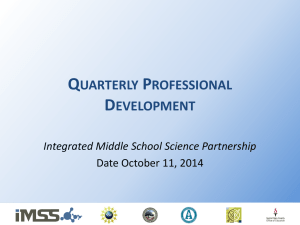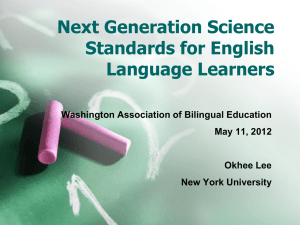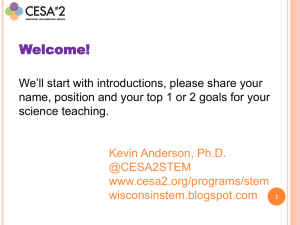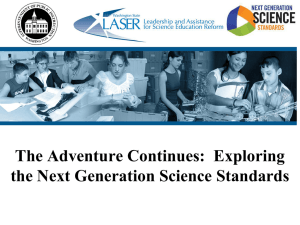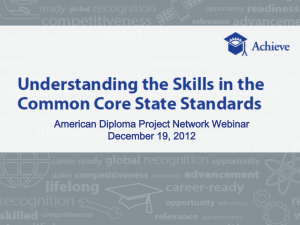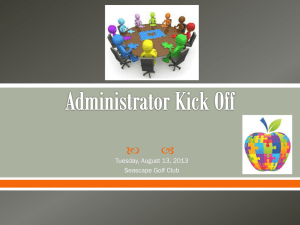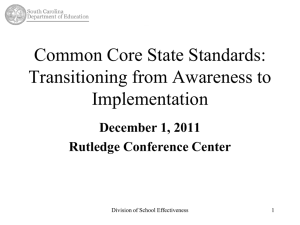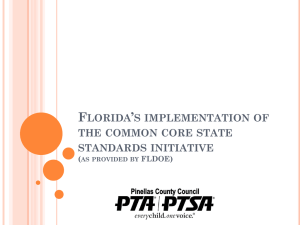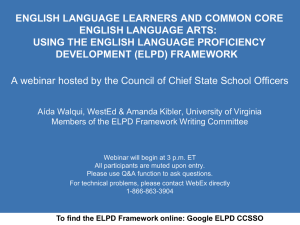Engaging English Language Learners 2/25/14 8
advertisement
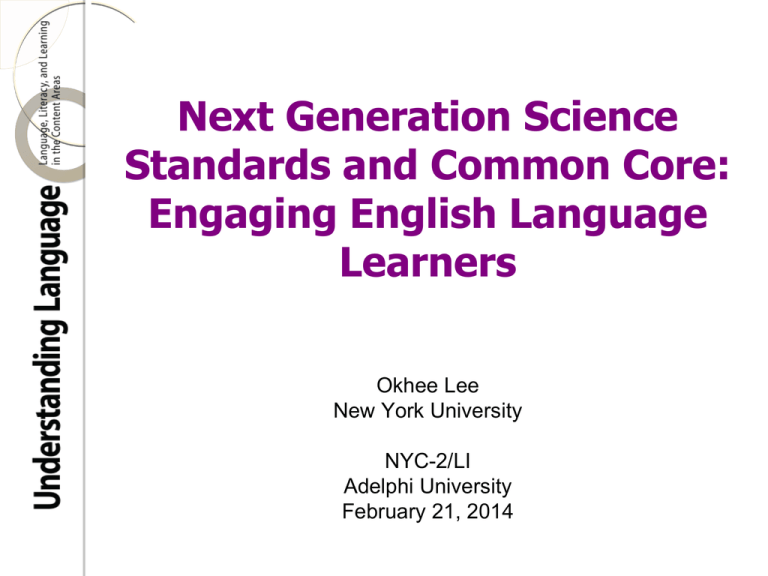
Next Generation Science Standards and Common Core: Engaging English Language Learners Okhee Lee New York University NYC-2/LI Adelphi University February 21, 2014 Topics Topic 1: Student Demographics National New York State New York City Topic 2: Disciplinary Practices in CCSS and NGSS with a Focus on ELLs Topic 3: Content and Language Topic 1: Student Demographics Four Accountability Groups 1. Economically disadvantaged students 2. Students from major racial and ethnic groups 3. Students with disabilities 4. Limited English proficient (LEP) students (the federal term) Poverty of students are eligible for free or reduced price lunch in 2010 of children live in poverty in 2010 U.S. Census Bureau National Center for Children in Poverty NYC Department of Education Race under 19 years old are racial minorities in 2010 U.S. Census Bureau NYC Department of Education Students with Disabilities Individuals with Disabilities Education Act (IDEA): of students ages 3-21 received special education services in 2009 in 2010 in 2010 National Center for Education Statistics NYC Department of Education English Language Learners speak a language other than English as primary language at home in 2011 participate in programs for ELLs in 2010 National Center for Education Statistics NYC Department of Education Take Home Message • The school-aged population is becoming increasingly diverse. • Science achievement gaps persist. • Academically rigorous standards and assessments are expected of all students in English language arts, math, and science. Discussion What information about changing demographics: 1. surprise you? 2. urge you to think about your own practices? Topic 2: Disciplinary Practices in CCSS and NGSS with a Focus on ELLs How can teachers promote CCSS and NGSS while supporting language development for ELLs? Understanding Language Initiative at Stanford University http://ell.stanford.edu/ How Language Develops • Rich contexts – desire and opportunity to engage and contribute • Multiple opportunities to hear and use (language) • Appropriate supports • Acceptance of “flawed” language How Science Understanding Develops • Rich contexts – desire and opportunity to engage and contribute • Multiple opportunities to hear and use (science ideas) • Appropriate supports • Acceptance of “flawed” language; for example non-scientific language Promoting Both Science and Language Learning for ELLs • ELs learn academic content as they participate in classroom discourse • ELs learn language as they engage with academic content • Focusing on both text and discourse gives ELs opportunities for extended engagement with complex ideas Disciplinary Practices in CCSS and NGSS • Raise the bar for content (academically rigorous) • Raise the bar for language (language intensive) • Call for a high level of classroom discourse (oral and written) across all content areas for all students Premise: what students do with language as they engage in content area learning Disciplinary Practices: From a Content Perspective • Raise the bar for content (academically rigorous) • Call for a high level of classroom discourse (oral and written) across all content areas for all students CCSS ELA and Literacy Student Capacities Key Features 1. Demonstrate independence 2. Build strong content knowledge 3. Respond to the varying demands of audience, task, purpose, and discipline 4. Comprehend as well as critique 5. Value evidence 6. Use technology and digital media strategically and capably 7. Understand other perspectives and cultures Reading: Text complexity and the growth of comprehension Writing: Text types, responding to reading, and research Speaking & Listening: Flexible communication & collaboration Language: Conventions, effective use, and vocabulary CCSS Math Mathematical Practices Core Ideas 1. Make sense of problems and persevere in solving them 2. Reason abstractly and quantitatively 3. Construct viable arguments and critique the reasoning of others 4. Model with mathematics 5. Use appropriate tools strategically 6. Attend to precision 7. Look for and make use of structure 8. Look for and express regularity in repeated reasoning K-5 Counting & Cardinality (K) Operations & Algebraic Thinking Number & Operations Fractions (3) Measurement & Data Geometry 6-8 Ratios & Proportional Relationships Number System Expressions & Equations Functions (8) Geometry Statistics & Probability 9-12 Number & Quantity Algebra Functions Modeling Geometry Statistics & Probability NGSS Science Standards Science & Engineering Practices 1. Ask questions (for science) and define problems (for engineering) 2. Develop and use models 3. Plan and carry out investigations 4. Analyze and interpret data 5. Use mathematics and computational thinking 6. Construct explanations (for science) and design solutions (for engineering) 7. Engage in argument from evidence 8. Obtain, evaluate, and communicate information Crosscutting Concepts 1. Patterns 2. Cause and effect 3. Scale, proportion and quantity 4. Systems and system models 5. Energy and matter 6. Structure and function 7. Stability and change Disciplinary Core Ideas 1. Physical Sciences 2. Life Sciences 3. Earth and Space Sciences 4. Engineering, Technology and Applications of Science SCIENCE MATH M1. Make sense of S1. Ask questions & S2. Develop problems & persevere define problems and use models in solving them S5. Use mathematics & S3. Plan & carry out investigations computational thinking M6. Attend to precision S4. Analyze & M4. Model with mathematics M7. Look for & make interpret data use of structure M8. Look for & express E2. Build strong content knowledge regularity in repeated E4. Comprehend as well as critique reasoning E5. Value evidence M2. Reason abstractly & quantitatively M3. Construct viable argument & critique reasoning of others S7. Engage in argument from evidence S6. Construct explanations & design solutions S8. Obtain, evaluate & communicate information E6. Use technology & digital media M5. Use appropriate tools strategically E1.Demonstrate independence E3. Respond to the varying demands of audience, talk, purpose, & discipline ELA E7. Come to understand other perspectives & cultures Source: Working Draft, 12-6-11 by Tina Cheuk, ell.stanford.edu Disciplinary Practices: From a Language Perspective • Raise the bar for language (language intensive) • Call for a high level of classroom discourse (oral and written) across all content areas for all students Old Paradigm Content Vocabulary Grammar Native-like fluency Language New Paradigm Content Discourse Text (complex text) Explanation Argumentation Text structure Sentence structure Vocabulary Grammar Language Language Discourse Text (complex text) Explanation Argumentation Text structures Sentence structures Vocabulary Grammar ELA Questions? Comments? Topic 3: Content and Language How can teachers promote CCSS and NGSS while supporting language development for ELLs? Development 1: Science and Language in Relation to NGSS • This article introduced the conceptual framework for language use in the science classroom as students engage in language-intensive science and engineering practices. • When students, especially ELLs, are adequately supported to “do” specific things with language, both science learning and language learning are promoted. Lee, O., Quinn, H., & Valdés, G. (2013). Science and language for English language learners in relation to Next Generation Science Standards and with implications for Common Core State Standards for English language arts and mathematics. Educational Researcher, 42(4), 223-233. NGSS Science and Engineering Practices and Language Functions CCSS ELA and Literacy Practices and Language Functions CCSS ELA and Literacy Practices and Language Functions (Continued) CCSS Mathematical Practices and Language Functions Features of Science Classroom Language Small Group Activity 1. Form a small group of 3 or 4 members. 2. Select one disciplinary practice from the CCSS for ELA/literacy, CCSS for math, or NGSS. 3. Unpack this practice in terms of (a) analytical tasks and (b) receptive and language functions. 4. Share your group work with the whole group. Development 2: English Language Proficiency Development (ELPD) Framework • To communicate to ELL stakeholders in states the language practices that ELLs must acquire for academic learning in CCSS and NGSS and for second language acquisition more generally • To provide guidance to states on how to use the expectations of the CCSS and NGSS as tools to create and evaluate ELP/ELD standards Pimentel, S., Castro, M., Cook, G., Kibler, A., Lee, O., Pook, D., Stack, L., Valdés, G., & Walqui, A. (2012). Framework for English language proficiency development standards corresponding to the Common Core State Standards and the Next Generation Science Standards. Washington, DC: Council of Chief State School Officers. English Language Proficiency Development (ELPD) Framework • NGSS (completed) Science & engineering practices and language functions Discipline-specific language in the K-12 science classroom • CCSS ELA ELA practices and language functions Discipline-specific language in the K-12 ELA classroom • CCSS Math Math practices and language functions Discipline-specific language in the K-12 math classroom California ELD Standards New York State Bilingual Common Core Initiative Development 3: English Language Proficiency (ELP) Standards • To highlight and elaborate on the critical language, knowledge about language, and skills using language that are: in CCSS for ELA/literacy and math and NGSS necessary for ELLs to succeed in school Council of Chief State School Officers. (in press). English language proficiency (ELP) standards. Washington, DC. Shafer Willner, L. (2013). Initial tour of the 2013 English language proficiency standards. Developed by WestEd for the Council of Chief State School Officers. Washington, DC: Author. English Language Proficiency (ELP) Standards 1. Construct meaning from oral presentations and literary and informational text through grade-appropriate listening, reading, and viewing 2. Participate in grade-appropriate oral and written exchanges of information, ideas, and analyses, responding to peer, audience, or reader comments and questions 3. Speak and write about grade-appropriate complex literary and informational texts and topics 4. Construct grade-appropriate oral and written claims and support them with reasoning and evidence 5. Conduct research and evaluate and communicate findings to answer questions or solve problems 6. Analyze and critique the arguments of others orally and in writing 7. Adapt language choices to purpose, task, and audience when speaking and writing 8. Determine the meaning of words and phrases in oral presentations and literary and informational text 9. Create clear and coherent grade-appropriate speech and text 10. Make accurate use of standard English to communicate in gradeappropriate speech and writing Development 4: ELPD Framework: Teacher’s Guide to the Science and Math Resources • To develop and validate a teacher’s guide that explains how the resources within the ELPD Framework can be used to generate classroom materials and design learning activities that support ELs’ engagement with NGSS and CCSS math Cook, G. (2013-2015). Teacher’s guide to the mathematics and science resources of the ELPD Framework. National Science Foundation, Discovery Research K-12. Development 5: Massive Open Online Course (MOOC) • Kenji Hakuta: “Constructive Classroom Conversations: Mastering Language for the Common Core State Standards” • This MOOC enablse teachers to promote constructive classroom discourse as students, especially ELLs, engage in the CCSS • Plans are under way to offer further MOOCs, including one on science classroom discourse in the context of the NGSS • As part of course assignments, the initial MOOC collected a large volume of teacher-recorded and transcribed samples of classroom discourse submitted by participants throughout the nation Questions? Comments? Take Home Messages • High academic rigor through the NGSS for all students, including ELLs • Both language demands and learning opportunities through the NGSS for all students, including ELLs • A new set of teachers’ knowledge and practices to enable all students, particularly ELLs, learn science according to the NGSS Thank you!

